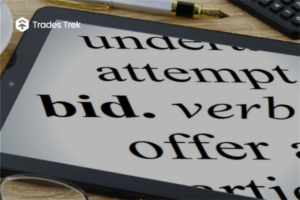Your investment strategy determines how much profit you make on the stock market.
In the ever-evolving landscape of investment, one debate that continually captivates both novice and seasoned investors is the battle between passive and active investment strategies. Although each method offers distinct advantages and disadvantages, investors have to understand which strategies best align with their investment goals and risk tolerance.
Practice investment strategies used on the Nigerian stock market for free on the Trades Trek Stock-Trading Simulator. Download on Android and IOS.
What is Active Investing?
Active investing involves hands-on management of investment portfolios. This strategy typically entails frequent buying and selling of assets. An active investor in the stock market buys stocks they believe will do well within a short period. They believe in their ability to capitalise on short-term fluctuations and uncover undervalued assets to maximise returns.
What is Passive Investing?
Passive investing on the other hand, adopts a more laid-back approach, focusing on long-term buy-and-hold strategies rather than frequent trading. The cornerstone of passive investing is index fund or ETF investing. Passive investors aim to replicate the performance of a broad market index, such as the S&P 500, by holding a diversified portfolio of securities. This method prioritises low costs, minimal portfolio turnover, and a “buy-and-hold” mentality.
Benefits of Passive Investing
Lower investment costs: Passive investing typically incurs lower costs compared to active strategies. Passive funds, such as index funds and exchange-traded funds (ETFs), have lower management fees and trading costs since they aim to replicate the performance of a market index rather than actively selecting securities.
Diversification: Passive investing offers broad market exposure, providing investors with diversified portfolios that spread risk across various asset classes and sectors. This diversification helps mitigate individual security risk and reduces portfolio volatility.
Efficiency and Simplicity: Passive investing is straightforward and accessible to investors of all levels of experience. With passive funds, investors can achieve market exposure and diversification with minimal effort, as there’s no need for ongoing research or active portfolio management.
Long-term profit potential: While passive strategies aim to match rather than beat the market, they have the potential to deliver competitive long-term returns. By tracking broad market indices, passive investors participate in overall market growth over time, capturing the returns of diverse asset classes.
Weaknesses of Passive Investing
Limited ability to beat the market: Passive investors accept market returns without attempting to outperform, which means they may miss out on opportunities to beat the market through active management strategies. While passive investing can deliver solid returns, it may not achieve the same level of outperformance as skilled active managers during certain market conditions.
Vulnerability to market downturns: Passive investors are fully exposed to market downturns and bear the full brunt of losses during periods of economic recession or market corrections.
Lack of customisation: Passive investing offers limited customisation options compared to active strategies. Investors cannot tailor their portfolios to specific investment goals, risk preferences, or ethical considerations beyond selecting from available index funds or ETFs.
Index limitations: Passive investing relies on market indices as benchmarks, which may not always accurately reflect investor objectives or market dynamics.
Benefits of Active Investing
Potential for Higher Returns: Active investors aim to outperform the market by making strategic investment decisions. They actively research and analyse securities, seeking opportunities for higher returns than the market average.
Flexibility and control: Active investing offers investors greater control over their portfolios. They can adjust their holdings in response to market trends, economic conditions, and company performance.
Risk Management: Active investors can actively manage risk within their portfolio by diversifying holdings, utilizing hedging strategies, and closely monitoring market trends.
Ability to capitalise on market inefficiencies: Active investors exploit market inefficiencies by identifying undervalued or overvalued securities. Through thorough analysis and research, they seek to capitalise on these discrepancies for profit.
Weaknesses of Active Investing:
Higher Costs: Active investing typically incurs higher costs compared to passive strategies. Expenses associated with research, trading commissions, and management fees can significantly affect returns over time, especially if performance fails to justify these costs.
Performance Uncertainties: Despite efforts to outperform the market, active investors face considerable uncertainty regarding their performance. Even skilled investors may underperform due to unpredictable market movements, unforeseen events, or behavioural biases.
Time and Effort Intensive: Active investing demands substantial time and effort to research investments, monitor market conditions, and execute trading decisions. This level of involvement may not be feasible or desirable for all investors, especially those with limited resources or expertise.
Emotional Bias and overtrading: Active investing can be susceptible to emotional biases, such as fear, greed, and overconfidence, which may lead to impulsive decision-making and excessive trading. Emotional responses to market fluctuations can undermine investment strategies and harm long-term returns.
Is Passive Investing More Profitable Than Active Investing?
The age-old question of whether passive or active investing is more profitable remains hotly debated among investors and financial experts. Passive strategies often outperform actively managed funds over extended periods due to lower costs and consistent market exposure. There are instances where skilled active managers can generate superior returns, particularly in niche markets or during periods of heightened volatility.




